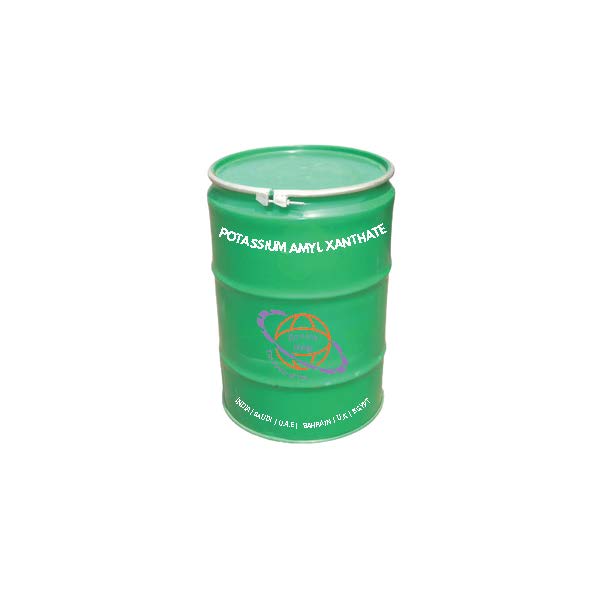Get in touch
+919879189757Working Hours
Mon - Sat 8:00 - 6:30Froth Flotation Reagent: PAX is primarily used as a collector in the flotation of sulfide ores.
Helps separate valuable minerals like copper, gold, nickel, and lead from the ore.
Increases the hydrophobicity of mineral surfaces so they attach to air bubbles and float.
Selective Mineral Recovery: Used to target specific sulfide minerals while leaving unwanted minerals behind.
Gold Ore Processing: Often used in combination with other reagents for gold extraction.
Enhances metal recovery efficiency during ore processing.
Helps reduce the loss of fine particles during mineral separation.
Rarely used in research or specialized chemical reactions, but its main value is in mining and flotation processes.


Price:
Price 50.0 INR
Minimum Order Quantity : 2000 Liters
Usage : Medical / Pharmaceutical Antiseptic, disinfectant (3 6% solutions for wounds, oral rinse) Sterilizing agent for medical equipment Food Industry (restricted uses, under regulated limits) Bleaching agent for flour, edible oils, and food packaging material Disinfectant in aseptic packaging (milk, juices) Washing/sanitizing agent for food contact surfaces Industrial Applications Textile and paper bleaching Wastewater treatment (oxidizing agent) Electronics (etching, cleaning) Propellant and fuel cells Household / Consumer Cleaning agent, stain remover, laundry bleach Hair bleaching formulations
Purity : 100 %
Poisonous : No
Melting Point : 0.43 C
Price 90.0 INR
Minimum Order Quantity : 1000 Liters
Usage : Usage of Acetone in Cosmetics Acetone is widely used in the cosmetic and personal care industry, primarily due to its solvent properties it effectively dissolves oils, greases, and synthetic substances. Common Cosmetic Uses of Acetone: 1. Nail Products Nail Polish Remover: Acetone is the primary active ingredient in many nail polish removers. It quickly dissolves nail polish, acrylics, gels, and glues used in artificial nails. Nail Surface Prep: Used to dehydrate and clean the nail plate before applying gel polish or acrylic nails, helping enhance product adhesion. 2. Cosmetic Tool Cleaning Used to clean makeup brushes, applicators, and other tools especially to remove oilbased or waterproof products. 3. Temporary Skin Cleansing In some professional or theatrical makeup settings, acetone may be used to remove heavy, longwear, or prosthetic adhesives from the skin (e.g., spirit gum, latex, siliconebased adhesives). However, this is done with caution and followed by moisturizing, as acetone is drying and potentially irritating to the skin. Why Acetone Is Used in Cosmetics: Fast evaporation: Leaves no residue. Highly effective solvent: Breaks down polymers and oils. Low cost and easy availability.
Purity : 99.5%
Poisonous : No
Melting Point : 94.7 C (or 138.5 F)
Price 200.0 INR / Kilograms
Minimum Order Quantity : 1500 Kilograms
Usage : 1. Cosmetics & Personal Care Preservative: Prevents microbial growth in creams, lotions, shampoos, etc. Solvent: Helps dissolve active ingredients and fragrances. Fragrance Ingredient: Adds a mild, floral scent. Viscosity Decrease Agent: Helps thin out formulations. 2. Pharmaceuticals Bacteriostatic Agent: Preserves multidose injectable medications (e.g., in penicillin vials). Local Anesthetic: Used in topical formulations for minor pain relief. Solvent: Carries active pharmaceutical ingredients in oral and injectable drugs.
Purity : 100%
Poisonous : No
Melting Point : Melting Point: 15 C (5 F)
Price 250.0 INR / Kilograms
Minimum Order Quantity : 1000 Kilograms
Usage : Usages of Cetyl Alcohol Cosmetics & Personal Care: Emollient to soften and soothe skin Emulsifier and stabilizer in creams, lotions, and conditioners Thickening agent to improve texture and consistency Conditioning agent in shampoos and hair treatments Provides a smooth, velvety feel in skin and hair products Pharmaceuticals: Base or thickener in ointments and creams Helps in formulation stability and controlled drug release Industrial: Used in lubricants, polishes, and wax blends
Purity : 100%
Poisonous : No
Melting Point : 48 C to 55 C (approximately 118 F to 131 F)